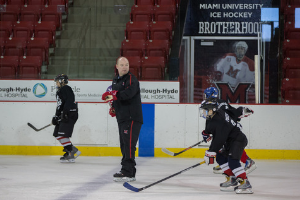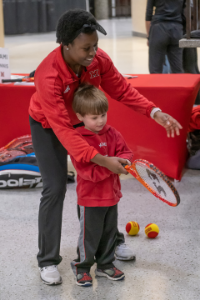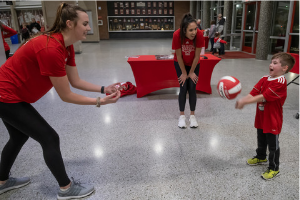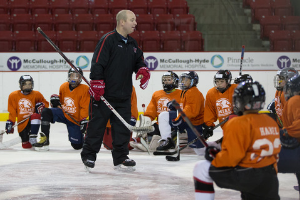Expectation, Bias, and the Profound Effect Coaches Can Have on Youth Sport


James M. Loy, Miami University
Never underestimate the power of a coach to make an impact. Especially in youth sport, where coaches can influence young athletes in ways that can reach far beyond a single game, or even an entire season.
According to Thelma Horn, Miami University professor of sport leadership and management, coaches can make or break sport for children. And, they can also have a profound effect on their physical and psychosocial development.
 “When kids are involved in youth sport, gradually the coach’s feedback starts to become more important,” Horn says. “Particularly between ages of eight and 16 or 18, the coach becomes the primary figure. More important than the parents. That starts at eight. But increases in importance into high school.”
“When kids are involved in youth sport, gradually the coach’s feedback starts to become more important,” Horn says. “Particularly between ages of eight and 16 or 18, the coach becomes the primary figure. More important than the parents. That starts at eight. But increases in importance into high school.”
That’s not to discredit parents. Their feedback is still important. But the contrast highlights how critical coaches can be, and how influential they quickly become.
Horn has built a prolific career around the scientific study of youth sport. Her research focuses largely on coach feedback, the positive and negative role it plays, as well as just how central it is to most players.
It may be common knowledge to say that good coaching can help build confidence, character, persistence, and pride. But the expectations that coaches set, the biases they hold, and the feedback they give can also determine, accelerate, or completely derail the trajectory of entire athletic careers.
Feedback matters
“Feedback is so important in youth sport because coaches serve as a source of competence information,” Horn says. “Until they get to 12, 13, or 14, they can't really self-evaluate. So as a parent, as a teacher, as a coach, the kind of feedback that I give has a lasting influence. Because you are basically telling them: Are you good at this? What can you do to get better? How do you fit in with your peers?”
Research shows that the amount, type, content, and tone of coach feedback can alter how athletes will perform and develop, both physically and mentally. And after years exploring the subject, Horn has identified four key dimensions to consider.
First, she says, feedback should be both positive and information-based. That is, feedback should explain, very clearly, what athletes are doing right, what they are doing wrong, and exactly how they can improve.
Second, feedback should support player autonomy. Rather than exhibiting a controlling style that, for example, prompts a coach to say, “I told you to do it this way.” Instead, a coach might say, “How do you think we could fix this?” This approach allows room for athletes to take initiative, act independently, and feel more self-worth.
Next, feedback should support a growth mindset. This teaches athletes that most abilities are fluid. Not fixed. That hard work will pay off. And here, Horn also makes an important distinction between process-praise and person-praise.
On the surface, person-praise may seem productive. In school, a teacher might say, “You are so smart!” Or in baseball, a coach might say, “You are a great hitter!”
However, person-praise can backfire.
“Person-praise basically says you either have it or you don't, and that's the problem,” Horn says. “Even at three or four [years old], if we're giving a lot of person-praise, we're not really giving them this idea that competence can be developed. But process-praise provides them with the idea that being good at anything is malleable. I can get better.”
So rather than praising the batter for a base hit. Process-praise instead focuses on the technique that made the hit possible. “Your balanced footing really gave you a nice level swing,” a coach might say.
Finally, feedback should also create an environment that is free from bias. This dimension urges coaches to resist stereotypes, which can not only hurt performance and motivation. Stereotypes can also feed into the self-fulfilling prophecy phenomenon.
When expectations affect experiences
Self-fulfilling prophecies happen when expectations become a reality, or when biases and initial judgments dictate athletic development and achievement.
Often, it forms a loop.
 First, a coach forms an expectation, which influences their treatment of athletes, including the type and frequency of the feedback they receive. This, then, can affect athlete performance, rate of learning, their sense of self, and motivation. All of which tend to conform to and, thus, confirm the coach’s original expectation, which is then reinforced and repeated.
First, a coach forms an expectation, which influences their treatment of athletes, including the type and frequency of the feedback they receive. This, then, can affect athlete performance, rate of learning, their sense of self, and motivation. All of which tend to conform to and, thus, confirm the coach’s original expectation, which is then reinforced and repeated.
For coaches, this phenomenon can be tricky to navigate because forming initial expectations is part of the job. A good coach needs to evaluate players, assess their skills, identify strengths and weaknesses, and then form a game plan.
However, problems occur when these initial expectations are based on person cues such as race, gender, height, weight, and body shape. And this problem can be compounded further if coaches fail to modify these expectations.
“Hopefully, that initial expectation is flexible,” Horn says. “That's the biggest thing. We make these initial judgments, which we do need to do in order to develop practice plans. But hopefully, when we get information to the contrary, we can change them.”
High-expectancy vs. low-expectancy
Coaches who exhibit these kinds of biases often perceive athletes as being either high-expectancy or low-expectancy players.
Young athletes are particularly vulnerable to this bias because most have not yet fully developed. Plus, all children develop at different rates. So, in many cases, it puts players on diverging paths that can either limit their potential or lead to outright failure.
A common scenario involves choosing early maturing children for elite or select teams. At an earlier age, they become faster and stronger than their later maturing peers, so they are often perceived to be better natural athletes.
“Starting around age eight, we separate kids into recreational and select,” Horn says. “And it's mostly early maturers, that get put on elite teams. The late maturers stay at the recreational level. So they don't get the coaching. They don't get those opportunities.” 
But this scenario is not always beneficial to the early maturers either. Because they can get locked into specialized roles too early. Then, once everyone else catches up, they are no longer exceptional.
“We see that in volleyball a lot,” says Horn. “Tall kids at nine, ten, eleven, twelve, are put at the net. And as long as they're good at hitting and blocking, people don't care if they can pass or set or play defense. The problem is when the tallest they get is 5 feet 8, which is fine. But I'm probably not going to play Division I college volleyball. Unless I have a stupendous jump, I'm not going to be competitive. Well, too bad I never learned the back row skills. Because I have no other place to go.”
Differences still exist. And that’s okay.
Even though creating an environment free from bias is key, Horn says it is not necessary to treat every young athlete the same.
There are differences between individuals. Skill levels will vary. Progression rates will be uneven. Some players will want feedback that reduces their anxiety. While others will thrive on information that drives performance. And so on.
Even so, Horn still offers two connecting threads of advice for all youth sport coaches who wish to make the experience more positive.
First, they should start with the expectation that everyone can improve. The growth mindset should always stay strong. Second, practices should be structured in ways that give everyone an equal chance to play.
“And then,” she says, “let the chips fall where they may. Some kids are going to develop and make select teams, and others aren't. As long as you don't predestine that, [you can] provide the opportunity for everybody to learn.”

